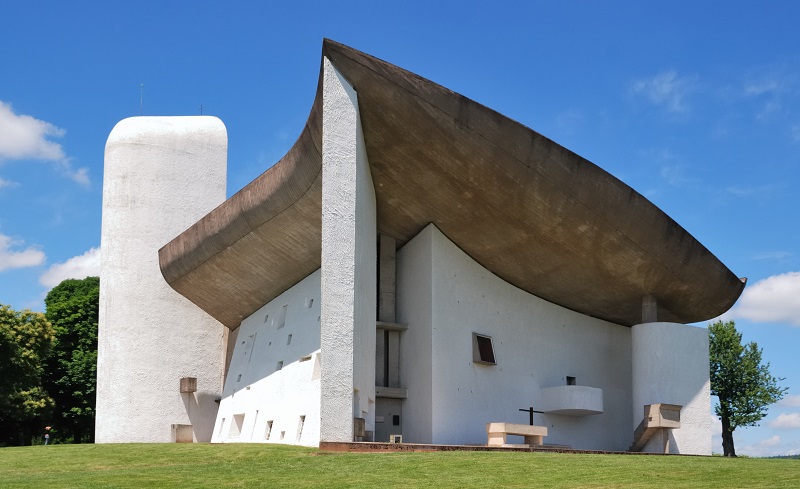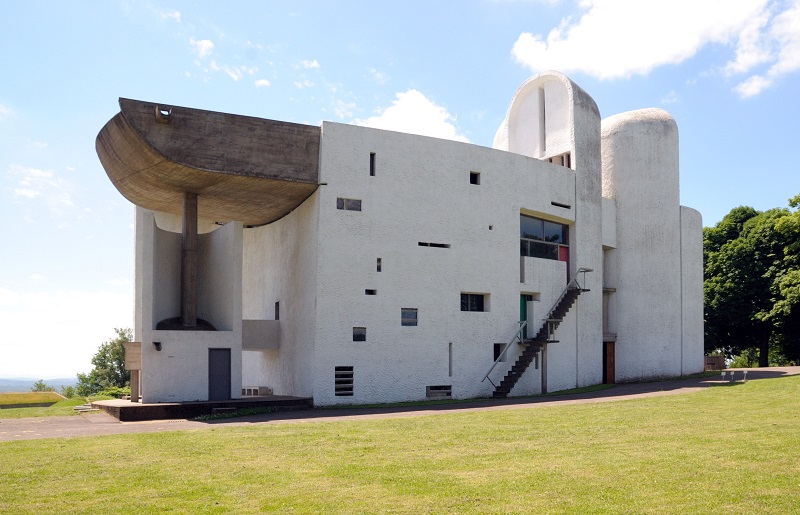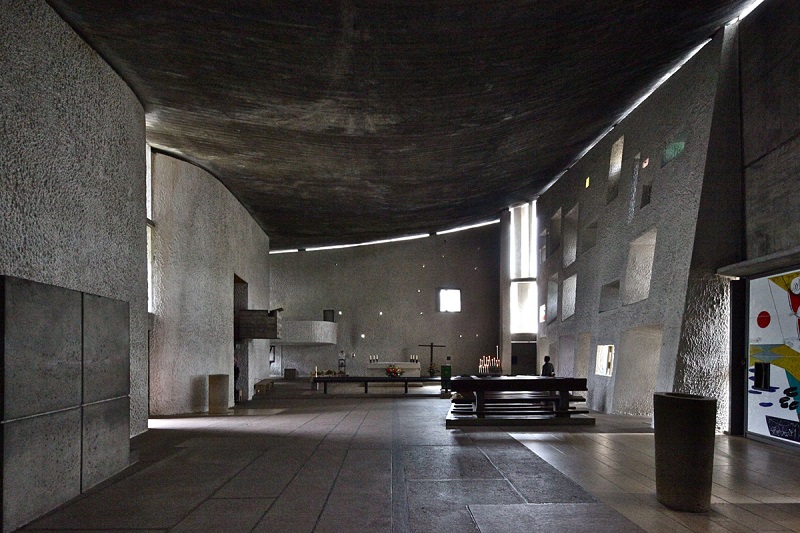Notre Dame du Haut
Contents |
[edit] Introduction
Notre Dame du Haut is a Roman Catholic chapel designed by Le Corbusier. Located on a hill near Belfort, Ronchamp, France, it is widely considered one of the most important buildings of the 20th century.
Commissioned to design the chapel in 1950, Le Corbusier saw an opportunity to depart from his trademark principles of standardisation and ‘machine aesthetic’ in response to the site, both physically because of the hillside location, and in terms of its historical legacy as a place of worship.
Notre Dame du Haut was built on the site of a 4th century Christian stone chapel which had been largely destroyed during the Second World War. Completed in 1955, Le Corbusier's chapel represents a defining move away from the characteristically sparse and functionalist form of Modernism, and today is regarded as one of his finest achievements.
[edit] Design and construction
Le Corbusier focussed on spatial purity and an uncomplicated design – two entrances, an altar and three chapels.
The building's envelope is formed by thick, gently-curving walls which provide structural support for a massive curvilinear roof and give the building its sculptural character. They also act as acoustic amplifiers, helping to reflect sound out over the fields.
The aerodynamic design of the monumental, curved concrete roof mimics the curvature of a wing and, despite its massive and heavy form, gives the appearance of weightlessness. The roof is supported by columns embedded in the walls rather than the walls themselves, making it appear to float above the building. The 10 cm gap between the roof and walls allows light to seep into the chapel.
Le Corbusier focused considerable time on the design of the south wall. It begins as a point on the east end, then expands to 10 ft thick on its west side, curving towards the south. The window openings slant towards their centres at varying angles, letting light enter the building in different directions.
Despite the complex layout suggested by the external appearance of the chapel, the interior is rather simple in plan. Le Corbusier’s intention was to create a meditative and reflective space. This is achieved in part by the stark white walls combined with the irregular arrangement of windows, which are glazed with a mixture of clear and coloured glass.
Three thick white walls curve inwards, creating smaller chapels at the sides of the main space. One is painted bright red, the other white. The internal and external walls are finished with mortar, sprayed onto the surfaces and whitewashed or painted. The roof is left raw.
The slope of the site is followed by the concrete floor towards the main altar. The floor is divided into a gridded pattern based on Le Corbusier’s innovative, modulor system of proportions.
[edit] Legacy
Despite being seen as a radical departure for Le Corbusier, the building actually adheres to many of the same principles of purity, openness and communality that informed his earlier work. Nevertheless, it was a contextual response to the site which inspired Le Corbusier to move away from the mechanistic style that he was known for at the time.
Today, the chapel remains an operational religious building, under the guardianship of a private foundation and welcomes 80,000 visitors a year.
[edit] Find out more
[edit] Related articles on Designing Buildings Wiki
Featured articles and news
Key points for construction at a glance with industry reactions.
Functionality, visibility and sustainability
The simpler approach to specification.
Architects, architecture, buildings, and inspiration in film
The close ties between makers and the movies, with our long list of suggested viewing.
SELECT three-point plan for action issued to MSPs
Call for Scottish regulation, green skills and recognition of electrotechnical industry as part of a manifesto for Scottish Parliamentary elections.
UCEM becomes the University of the Built Environment
Major milestone in its 106-year history, follows recent merger with London School of Architecture (LSE).
Professional practical experience for Architects in training
The long process to transform the nature of education and professional practical experience in the Architecture profession following recent reports.
A people-first approach to retrofit
Moving away from the destructive paradigm of fabric-first.
International Electrician Day, 10 June 2025
Celebrating the role of electrical engineers from André-Marie Amperè, today and for the future.
New guide for clients launched at Houses of Parliament
'There has never been a more important time for clients to step up and ...ask the right questions'
The impact of recycled slate tiles
Innovation across the decades.
EPC changes for existing buildings
Changes and their context as the new RdSAP methodology comes into use from 15 June.
Skills England publishes Sector skills needs assessments
Priority areas relating to the built environment highlighted and described in brief.
BSRIA HVAC Market Watch - May 2025 Edition
Heat Pump Market Outlook: Policy, Performance & Refrigerant Trends for 2025–2028.
Committing to EDI in construction with CIOB
Built Environment professional bodies deepen commitment to EDI with two new signatories: CIAT and CICES.
Government Grenfell progress report at a glance
Line by line recomendation overview, with links to more details.
An engaging and lively review of his professional life.
Sustainable heating for listed buildings
A problem that needs to be approached intelligently.
50th Golden anniversary ECA Edmundson apprentice award
Deadline for entries has been extended to Friday 27 June, so don't miss out!
CIAT at the London Festival of Architecture
Designing for Everyone: Breaking Barriers in Inclusive Architecture.
Mixed reactions to apprenticeship and skills reform 2025
A 'welcome shift' for some and a 'backwards step' for others.





























